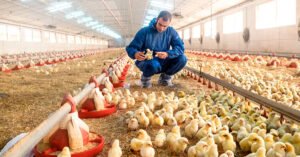Comprehensive Report on Veterinary Services: Challenges and Solutions with Global Comparisons

Dr. Majed Hamed Al Saegh / poultry pathologist / Australia
Introduction
The veterinary profession plays a vital role in safeguarding animal health and welfare, which in turn impacts human health, the economy, and public safety. Veterinary services are essential for preventing zoonotic diseases, ensuring food safety, and managing the health of both companion and livestock animals. However, a major challenge that many countries face, including Iraq, is the imbalance between the number of veterinary professionals and the number of animals that need care. This imbalance results in underutilized veterinary professionals and insufficient coverage for animal health services.
The purpose of this report is to explore the current situation in Iraq, compare it with other countries, and propose solutions to address the discrepancies between veterinary education, workforce, and animal populations.
Section 1: Current Veterinary Challenges in Iraq
1.1 Veterinary Education and Workforce in Iraq
Iraq has a large number of veterinary colleges producing thousands of graduates every year, but the country is facing significant challenges related to the alignment between the number of veterinarians and the animal population.
Excessive Graduates: There are approximately 15 veterinary colleges in Iraq, each graduating more than 2,000 veterinarians annually. This results in an oversupply of veterinary professionals.
Lack of Adequate Animal Population: Despite the large number of veterinarians, the country lacks the corresponding number of animals that require consistent care. According to the World Organisation for Animal Health (WOAH), Iraq’s animal population is as follows:
Buffaloes: 394,500 animals
Cattle: 1,591,500 animals
Goats: 669,150 animals
Sheep: 7,495,200 animals
These numbers show that while Iraq has a large population of sheep and cattle, the number of animals is still not enough to justify the large number of veterinary graduates each year.
Quality of Education: Many veterinary graduates in Iraq face a gap in practical training. While they may have the theoretical knowledge, their experience with actual fieldwork and diverse animal health cases is limited.
1.2 Impact of Oversupply of Veterinarians
Unemployment and Underemployment: The oversupply of veterinarians, combined with the limited demand for animal health services, leads to significant unemployment and underemployment within the sector.
Quality of Services: Due to insufficient field experience and a mismatch between the number of veterinarians and animals, many newly graduated veterinarians struggle to find relevant jobs, which undermines the quality of services available to the public.

Section 2: Global Comparison of Veterinary Services
2.1 United States
Veterinary Workforce: The United States has approximately 130,000 veterinarians serving a population of more than 200 million animals (including both pets and livestock). The country has a well-established network of veterinary clinics and hospitals, and there is a relatively balanced ratio of veterinarians to animals.
Quality of Education: U.S. veterinary schools are among the best in the world, providing extensive theoretical and practical training to their students. The United States also has stringent requirements for continuing education and specialization for veterinarians.
Challenges: Despite the relatively balanced ratio of veterinarians to animals, rural areas in the U.S. experience shortages of veterinary services, especially in specialized fields such as large animal care and food animal medicine.
2.2 India
Veterinary Workforce: India has a large veterinary workforce, with over 50,000 veterinarians. However, with a livestock population exceeding 600 million, there is a significant shortage of veterinarians to meet the growing demand for animal health services.
Challenges: The country faces issues with the quality of veterinary education, particularly in rural areas. Many veterinary colleges lack modern equipment and facilities for hands-on training, and there are few opportunities for students to gain practical experience.
Solutions: India has started implementing reforms to improve veterinary education, focusing on upgrading facilities, providing scholarships for veterinary students, and improving access to continuing education.
2.3 Canada
Veterinary Workforce: Canada has a robust veterinary workforce with over 4,000 veterinarians, serving a livestock population of 40 million. The veterinary system is highly developed, with excellent infrastructure and support for both private practice and research.
Quality of Education: Canadian veterinary colleges are internationally recognized for their rigorous academic programs and excellent practical training. Continuing education programs are widely available for veterinarians seeking specialization.
Challenges: While Canada has a high standard of veterinary care, the demand for large animal veterinarians, especially in rural regions, still exceeds the supply.
2.4 United Kingdom
Veterinary Workforce: The UK has approximately 24,000 veterinary professionals providing services to more than 100 million animals. The veterinary workforce is spread across both urban and rural areas, ensuring widespread access to services.
Quality of Education: UK veterinary schools maintain high standards, offering comprehensive training in both small and large animal medicine.
Challenges: In rural areas of the UK, the shortage of large animal veterinarians continues to be a challenge, with a focus on improving access to services for farmers.
Section 3: Solutions for Iraq’s Veterinary Sector
3.1 Aligning Veterinary Education with Market Demand
Regulating Admission to Veterinary Colleges: One of the key solutions for Iraq is to regulate the number of veterinary students admitted to colleges each year, ensuring that the number of graduates aligns with the needs of the market. This could involve setting quotas for veterinary college admissions based on the real demand for veterinary professionals in the country.
Revamping Veterinary Education: Iraq should focus on improving the quality of education, particularly in terms of practical training. This includes investing in modern training facilities, offering more hands-on experiences in farms and veterinary clinics, and creating partnerships with international universities for faculty development.
3.2 Encouraging Veterinary Specializations
Training Veterinary Technicians: Instead of focusing on a large number of full-fledged veterinarians, Iraq should invest in training veterinary technicians and assistants who can support veterinarians in less complex tasks. This would ease the workload of veterinarians and ensure a better distribution of resources.
Specialization Programs: Iraq could introduce specialization programs for veterinarians in high-demand fields, such as poultry medicine, livestock care, and public health. This would help cater to the specific needs of different sectors and improve the quality of veterinary services.
3.3 Strengthening Veterinary Infrastructure
Building More Veterinary Clinics: In rural areas where veterinary care is limited, the Iraqi government should focus on building more veterinary clinics and providing them with the necessary equipment and staff to handle the specific needs of these areas.
Expanding Animal Health Programs: Iraq should work on increasing the population of livestock and poultry through national programs aimed at supporting small farmers, which would create more demand for veterinary services.
3.4 Encouraging Private-Public Partnerships
Collaboration with the Private Sector: By collaborating with private veterinary clinics, Iraq can expand the reach of its veterinary services, especially in areas that are not easily accessible to government services. The government can offer incentives to private practices to open in underserved regions.
International Cooperation: Iraq should seek international partnerships with veterinary organizations and universities to strengthen the veterinary sector, provide expertise, and learn from best practices in other countries.
Section 4: Policy Recommendations
4.1 Government Action
Investing in the Veterinary Sector: The Iraqi government needs to invest in both infrastructure and human capital for the veterinary sector. This includes upgrading veterinary facilities, supporting the education system, and ensuring that veterinarians are properly equipped with the resources they need to work effectively.
Setting Up a National Veterinary Council: A national veterinary council could be established to regulate the profession, ensuring that all veterinarians are properly trained and licensed. This body could also help in creating guidelines for the number of veterinarians based on animal populations.
4.2 Collaboration with International Organizations
Collaborating with Global Veterinary Networks: Iraq should actively participate in international veterinary networks, such as the World Organisation for Animal Health (OIE), to improve the training and standards of its veterinary profession. Such collaborations could provide Iraq with access to new technologies, training programs, and funding.
Conclusion
The veterinary sector in Iraq faces a significant challenge in terms of the imbalance between the number of veterinarians and the demand for animal health services. This issue is exacerbated by the rapid growth in the number of veterinary graduates and the lack of sufficient animal populations to justify their employment.
By adopting solutions such as regulating the number of veterinary graduates, enhancing training quality, encouraging specializations, improving veterinary infrastructure, and fostering private-public partnerships, Iraq can better align its veterinary workforce with the needs of the market. Moreover, international cooperation can play a crucial role in modernizing the sector and ensuring that Iraq’s veterinary services are up to global standards.



